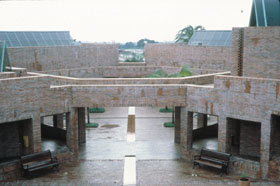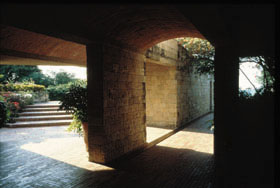
| ||
 | ||
 The Quimbaya Culture Museum in Armenia, Colombia PHOTO: RICARDO CASTRO |
Heralding Salmona's oeuvre
 Casa del Fuerte de San Juan de Manzanillo, Cartagena de Indias PHOTO: RICARDO CASTRO |
|
ERIC SMITH | Architecture professor Ricardo Castro's first encounter with Colombian architect Rogelio Salmona was as an undergraduate at the Universidad de los Andes in Bogotá in the 1960s.
But it wasn't until much later, in Quebec, that he began to develop what he calls an "obsession" with Salmona's work. The two Colombians met again in 1982 at a conference on architectural theory and criticism in Montreal and became friends. And when Salmona invited the McGill professor to visit his Casa del Fuerte de San Juan de Manzanillo (an official government building used as the president of Columbia's "House for Illustrious Guests") Castro discovered "an incredible complex, a wonderful network of gardens and courtyards, a marvelous world of exuberant vegetation." Since that trip in 1988, Castro has returned to Colombia over and over again to document Salmona's work. Over the course of 10 years and two sabbaticals, he has accumulated thousands of photographs and written several critical theory texts exploring themes in Salmona's work.
One result of all this work is a beautiful book, Rogelio Salmona, published in English and Spanish editions by Villegas Editores. Dozens of Castro's photographs capture eleven of Salmona's projects, from the magnificent skyscrapers of the Torres del Parque Residential Complex, to the extraordinary beauty of the Casa del Fuerte de San Juan de Manzanillo. And another book is in the works, this one a more scholarly exploration of the architect's oeuvre. But even in the current coffee table edition, Castro has included several critical essays for a book that he hopes will appeal both to the general public and to architects. The essays draw on classical texts and Latin American writers like Julio Cortázar, Alejo Carpentier, Octavio Paz and Gabriel García Márquez, to explore the roots of Salmona's architecture. Castro uses syncretism, defined as "the combination of different forms of belief or practice," to describe an architecture that draws from three traditions to create a uniquely Latin American work. Salmona draws inspiration from the pre-Colombian tradition of indigenous societies, "an incredible source" that according to Castro, "has not really yet been mined for all its complex ornamentation and its use of water." Salmona also draws on a Spanish colonial tradition, itself influenced by its Islamic history in the Alhambra and Generalife, and on the work of famed architect Le Corbusier, his teacher in France in the 1950s. The result is an architecture that Castro says is characterized by "lo real-maravilloso" or the marvelous real, a concept introduced by Cuban writer Alejo Carpentier that is related to, but distinct from, the magical realism familiar to readers of Latin American literature. It describes the surrealism that is generated by the landscape and history of Latin America, the real made magical. Carpentier first used it to describe the Haitian ruins of Henri Cristophe's Palais de Sans-Souci. For Castro, it was evoked by his first visit to the Casa del Fuerte de San Juan de Manzanillo. Another aspect of Salmona's work that is intriguing to Castro is his use of water. Many of his buildings feature sun-drenched patios that are traversed by culverts reminiscent of Granada's Generalife. The use of elements, earth, air, fire and water, has been a particular interest of Castro's for some time and has been the subject of graduate seminars he's conducted at the School of Architecture. Although renowned throughout Latin America, Salmona is not well known in North America. Castro says there is an emphasis in the Northern Hemisphere on East-West exchanges, that North Americans tend to look towards the architectures of Europe and Japan and bypass not only Latin America but also Africa and Australia. "It's never on a vertical axis," says Castro. "I think it was the same thing in literature until the 1960s when suddenly there was a lot of interest in the works of Borges, Cortázar and García Márquez."
|
|
| |||||